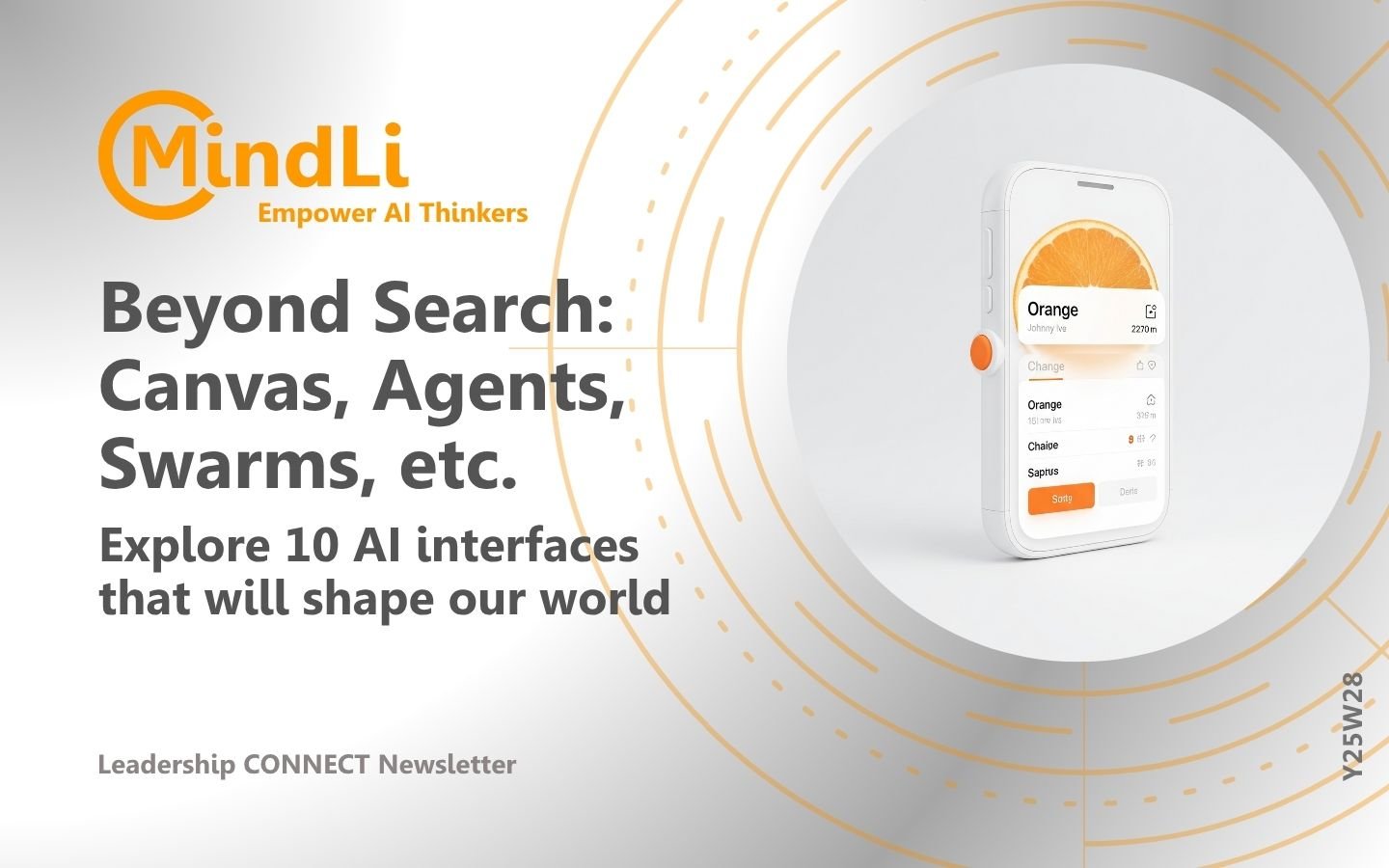Greetings, AI Thinkers,
For many, AI still feels like a smarter Google search bar. But the reality is far richer.
AI is moving beyond search into new interfaces—chat, voice, canvas, agents, swarms, and more—that redefine how we think, create, and act.
In this post, I share 10 AI interfaces that will shape the way we engage with this technology. These aren’t just features—they’re the building blocks for personal and organizational transformation.
Happy Thinking,
Dr. Yesha Sivan and the MindLi Team
P.S. Feedback? Email me.
Spark of the Week: Beyond Search – Canvas, Agents, Swarms, etc. — Explore 10 AI interfaces that will shape our world (Source: Yesha on Human Thinking)
AI Interface Beyond Search
We’re celebrating nearly three years of AI’s rapid evolution since OpenAI’s GPT-3.5 release in November 2022. Yet even today, many still think of AI as just an advanced Google search, with interfaces resembling a familiar search bar.
This familiar interface made it easy for people to interact with AI. But it also hides the advanced interfaces AI now offers.
To understand AI personally and organizationally, we need to recognize the unique value of each interface. By going beyond the familiar, we unlock AI’s full potential in our lives. Here are some examples.
Ten Examples of AI Interfaces to Consider
- Chat (not Search): Working with AI can be a search replacement for quick facts or answers. But for deeper questions, projects, and issues, we use chat: we ask an initial question and then delve deeper with follow-ups, exploring pros and cons, other angles, and verifications. In fact, the art of chat is really a modern version of the art of research.
- Voice: Using AI with spoken language allows for natural, hands-free interactions. You can give commands, ask questions, and receive responses as if you’re conversing with a human. Voice interfaces are essential for multitasking and accessibility.
- Canvas: Here, AI becomes your creative partner in a visual and interactive space. You can brainstorm ideas, design workflows, or create mind maps, using the canvas as a playground for structured and unstructured thinking.
- Agents: Think of these as autonomous AI helpers. You assign them a goal or task, and they execute it for you—managing workflows, handling repetitive work, or even negotiating with other systems on your behalf.
- Swarms: One level up. Instead of one AI, imagine many working together as a coordinated team. Swarms tackle complex challenges by dividing them into smaller pieces and collaboratively solving them for faster and more robust results.
- Mixed Reality: By blending AI with augmented or virtual reality, this interface immerses you in environments where AI enhances your perception and interaction. Ideal for training, simulations, or experiential learning. (p.s., still not there but getting there, hopefully soon with glasses and not bulky helmets).
- Personalized Interfaces: AI builds custom interfaces that adapt to your preferences and behaviors. For example, dashboards highlight what matters most to you, offering curated insights, recommendations, and quick access to key actions.
- Gesture & Expression Recognition: This interface reads your physical movements and emotions, letting you control AI with gestures or facial expressions. It makes interactions more intuitive and human-like, especially in physical environments.
- Embedded AI: Here, AI is woven directly into the activity you’re doing. For example, while driving, the car’s systems anticipate needs, suggest routes, and optimize your experience without requiring explicit commands.
- My Context: AI uses your own prior knowledge, preferences, and ways of thinking to tailor its outcomes. This interface helps align AI responses with your projects and thinking styles, making the interaction highly personal and context-aware.
Bottom Line: Actions for AI Thinkers
- If you are developing knowledge (such as posts, memos, or short-form research), use Canvas in OpenAI or artifacts in Claude for richer coworking.
- If you are a leader who wants to chat, try using voice—it’s magical (you may wish to explore [2]).
- Use system and project prompts to “teach” AI about your own preferences. From time to time, edit and update the system memory.
Links
[1] https://openai.com/index/introducing-canvas/ – OpenAI introduces Canvas.
[2] https://elevenlabs.io/ – for voice demos.
[3] https://help.openai.com/en/articles/8590148-memory-faq – more about OpenAI memory.
About MindLi CONNECT Newsletter
Aimed at AI Thinkers, the MindLi CONNECT newsletter is your source for news and inspiration.
Enjoy!
MindLi – The Links You Need
General:
- Website — MindLi.com — All the details you want and need.
- LinkedIn — MindLi 🌍 GLOBAL Group — Once a week or so, main formal updates. ⬅️ Start here for regular updates.
- WhatsApp — MindLi Updates — If you need it, the same global updates will be sent to your phone for easier consumption. This is similar to the above Global group — once a week or so.
- Contact us – We’re here to answer questions, receive comments, ideas, and feedback.
Focused:
- LinkedIn — MindLi 🧠 AI Group — More technical updates on AI, AGI, and Human thinking. ⬅️ Your AI ANTI-FOMO remedy — Almost Daily.
- LinkedIn — MindLi 👩⚕️HEALTHCARE Group — Specifically for our favorite domain — healthcare, digital healthcare, and AI for healthcare — Weekly.
- LinkedIn — MindLi 🛠️ FOW – Future of Work Group — thinking about current and future work? This is the place for you — Weekly.
- LinkedIn — MindLi 🕶️ JVWR – Virtual Worlds Group — About virtual worlds, 3D3C, JVWR (Journal of Virtual World Research), and the good old Metaverse — Monthly.
- LinkedIn — MindLi Ⓜ️ Tribe Group — Our internal group for beta testers of MindLi, by invite — when we have updates, call for advice, need for testing, etc (also ask about our special WhatsApp group).



